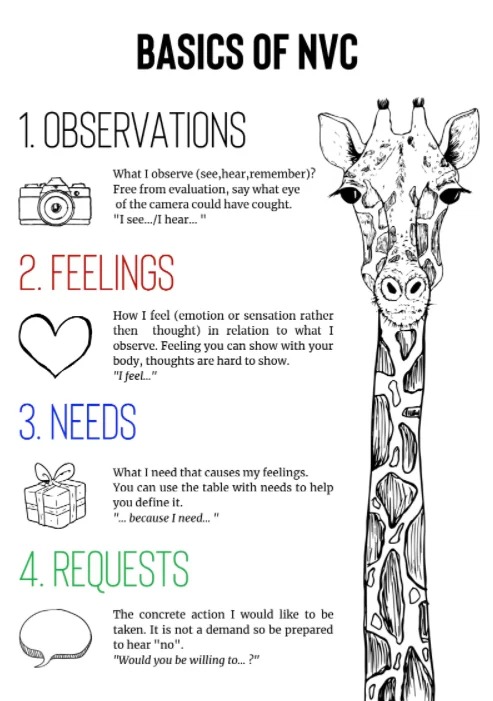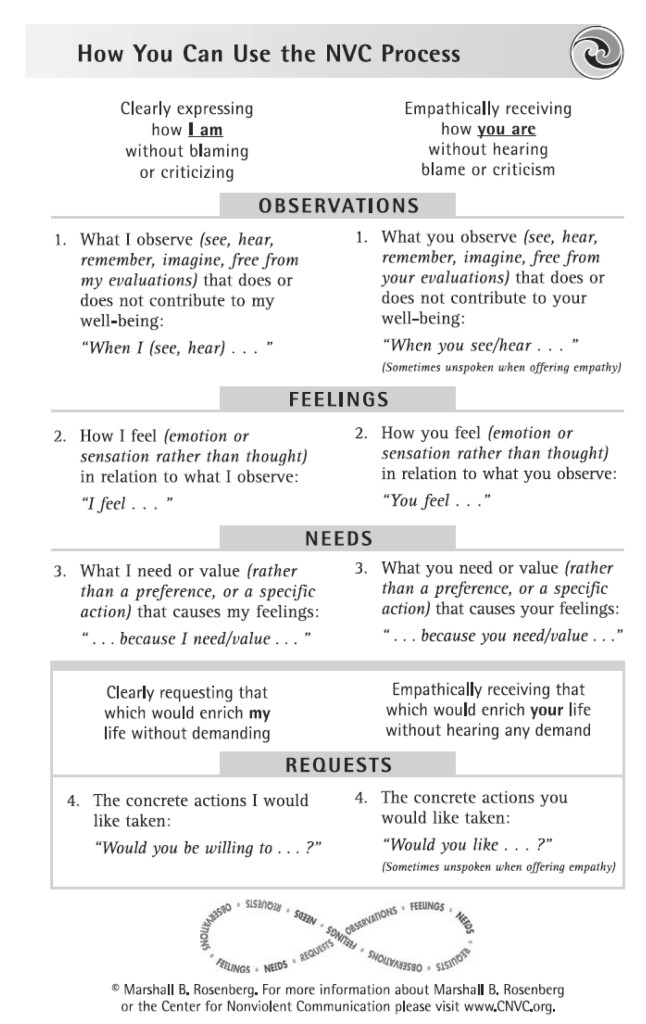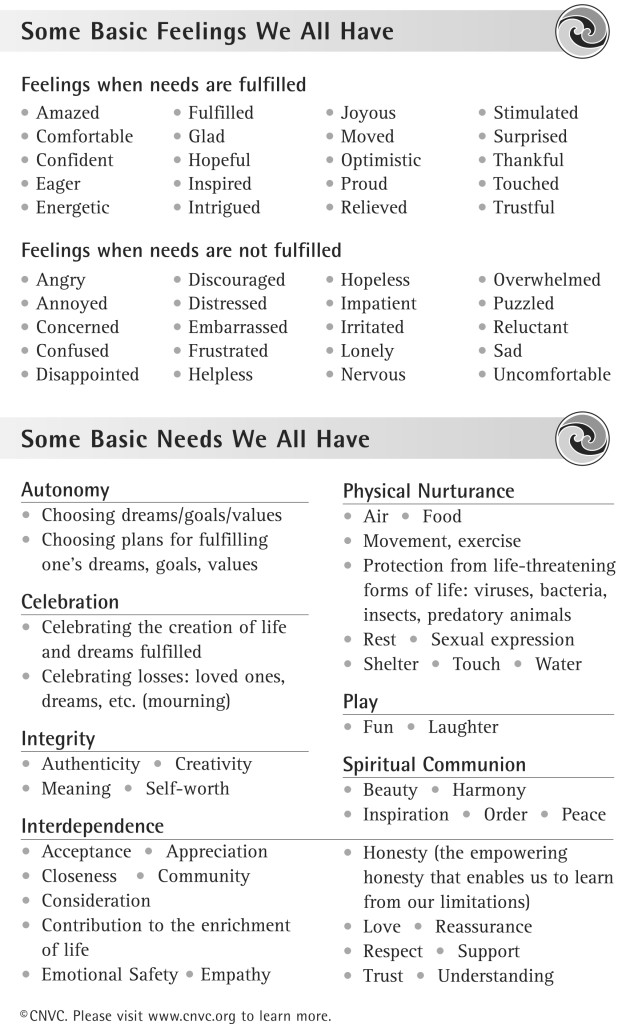Wouldn’t it be great to get our needs met without angry confrontations, arguments, and misunderstandings? Wouldn’t it be great to actually be heard and have our needs met while also actually hearing our family/friends/lovers’ words and helping them get their needs met too? NVC is one of the best communication tools I’ve found so far to do this.
A year ago I discovered NVC from my amazing friend Mia. It’s a style of communication that uses epithetical listening and honest expressing to focus on getting everyone’s needs met. It’s a 4 step framework for a dialogue of understanding. I listened to the audio book (by Marshal Rosenberg) while hiking the PTC last year and it’s wonderful… and it’s also a lot to remember. I was just watching a bunch of NVC videos this evening to give myself a refresher on the 4 steps and I figured I’d share while it’s all fresh in my mind.
I just filtered through a lot of material and here are the 3 best images and 2 best intro videos I found for someone new to NVC and anyone wanting to practice NVC. (Images below, in this post. Videos at the end of this post.)
CAUTION: each of the 4 NVC steps take practice and can be done incorrectly. NVC takes time and practice. Be gentle with yourself and each other. This is why I went looking for good example videos and cheat sheets, because I wanted to practice and make this a habit for myself.
Here is a Summary of the 4 Steps of an NVC Dialogue:
Step 1. Observation (not judgment or criticism)
Step 2. Feeling (not a thought, or pseudo feeling, or interpretation of a feeling)
Step 3. Need (not a demand, or a preferred strategy for doing something. Not, “I need you to xyz.”)
Step 4. Request (not a demand. Not, “I need you to xyz.”)
I like to add a step zero. My personal Step 0. is saying “I’m struggling. Can you help me?” (Not “I have an issue” or “We have a problem”.) This is also a good time to check-in with “Is now a good time to talk? Do you have the spoons to hold space for me?”
Example: “I’m struggling. Can you help me? […] When the pots and pans that I’m about to use to make myself dinner with are dirty already, I feel frustrated and nervous. I have a need for food and a need for autonomy. Can you help me figure out how we can both get our needs met when it comes to the pots and pans?”
Notice that doesn’t judge or blame anyone. No one is being attacked. It also doesn’t tell the other person how they “should” be or what they “should” do. It’s an offer to brainstorm something that works for everyone.
A little detail on the 4 steps:
Step 1. Make an Observation (not judgment or criticism). This is the hardest step for me. It’s why I went looking for videos. An observation is judgement free. EX: “the car was going 70mph” is an observation. “The car was speeding,” is a judgement. “He drank 8 beers in 2 hours,” is an observation. “He drank too much,” is a judgement. Observations are facts. Judgements are our interpretation of the facts that easily sounds like blame and turn into arguments. Security cameras and audio recordings are facts. Our interpretation of the recordings are judgements. Now add heightened emotions and it can get really hard to not have judgements fall out of our mouths.
Step 2. Share what you are Feeling (not a thought, not a pseudo feeling, or an interpretation of a feeling.) Don’t start explaining the feeling. “I feel _____,” then go to the next step. There is a cheat sheet image below with a list of feeling that are not pseudo feelings. Surprisingly, there are a lot of “pseudo feelings” that are thoughts and judgements masquerading as feelings. Saying, “I feel unheard,” is a pseudo feeling. It projects blame. It’s an interpretation of one’s feelings which may have been disappointed, frustrated, and irritated. “I feel unheard” also gets received as, “You are not listening.” (aka blame) That’s why I found and attached the image with lists of feelings that don’t come across as attacking or blaming. Real feelings can’t be argued with. “I feel disappointed, frustrated, and irritated,” is not something people can debate. “I feel unheard,” can provoke a, “I am too listening! I’ve been listening to you go on and on for over an hour!”
Step 3. State the Need that is not being fulfilled (not a demand, or a preferred strategy for doing something. Not, “I need you to xyz.”) Again, I found the cheat sheet from the book (image above) because it’s often hard to home in on real needs versus strong preferences. For example: “I need you to wash the pots and pans after you use them,” is not a need. That is a preference and it is a demand. Other people will have their own preference as well. Saying, “I have a need for food and a need for autonomy,” outlines two things that all human needs.
Step 4. Make a Request (not a demand. Not, “I need you to xyz.”) This one is also hard because it’s hard to word a request when emotions are high. A request is something the other person can say “no” to without any penalty or punishment. If we make a request, receive a “no,” and then fly off the handle, then it was never a request at all. It was a demand. People rarely want to be told what to do. Rather than agonizing over what to request and how to word it perfectly, I often ask, “Can you help me figure out how we can both get our needs met?” That’s a request for teamwork and makes it clear that the intention is to get both our need met and not my needs met at the expense of yours. That is when a bunch of different solutions collaboratively surface. It’s not me vs you, it’s us vs the struggle.
Finally, NVC can be done regardless of whether or not the other person knows the 4 steps or not. It’s not easy but it’s amazing. It just takes some focused listening. When someone comes at us with emotion or blame, we listen, we try to fill in the blanks for each of the 4 steps, and we ask them to verify or clarify what we heard. We listen for and confirm their Observation, Feeling, Need, and Request.
For example, someone says to us, “Why are all the pans dirty again!? You’re not the only one who lives here you know! You’re so inconsiderate and lazy!” We pick out 1 or more of the 4 steps and ask for verification and clarity. “Okay, you seem angry (their feeling) because the pans are dirty at this moment (their observation), is that correct? Okay, I can see how this situation would be frustrating (validating their feelings). You sound like you have a need that involves the pans being clean (their request) and a need for consideration (their need) as someone who lives here. Am I hearing you right? If I wash the pans right now, is that what you’re asking for? (their request)”
It’s pretty amazing how clarifying each of these 4 steps will lead to someone calming down simply because they are being listened to and understood. Once people are calm and understood, solutions tend to work themselves out in a few more minutes.
But don’t take my word for it, try it. I think NVC is very self-evident. When I’m doing it right, it works. When it doesn’t work, I usually find I missed a step or forgot it all together because emotions can do that sometimes.
Anyways, I thought I’d share and I also want to be able to come back and re-read all that at any time so I can refresh myself. Maybe I’ll just copy/paste it to a website blog post. Thanks for reading! Please feel free to bring any of this up in person and practice any of these steps with me. The more we practice, the more we’ll all be able to get our needs met! The more we practice on the little struggles now, the easier the big struggles will be in the future.
Here are those videos:
Great (5min) Summary Video of the 4 steps with an example: https://youtu.be/NYkgbrZSAY0
A more detailed (20min) video of walking through the steps and demos of ways that do and don’t work. https://youtu.be/8b7NOYMuFCQ
What next?
If you are interested in this topic, you might like my Communication 101 series over on KinkyPoly.com where I share everything I’ve ever learned about communication through conflict and when emotions are elevated. (Confession: I learned most of it “the hard way” and I’d love to save others the heartache. ;)



